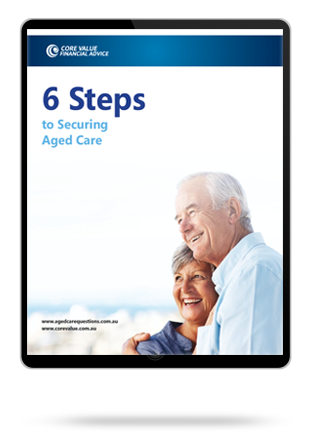As part of the aged care process, the government assesses a person’s income and assets in determining the fees and costs required to pay for aged care. This is called the income and assets assessment test.
In this article, we will discuss exactly what the assets test is, why it’s important, and how to apply.
In This Article
What Is the Income and Assets Assessment Test for Aged Care?
The goal of the aged care assets test is to determine if a person is eligible to receive a subsidy for some or all of the costs towards aged care. This is a requirement for anyone entering aged care.
The income and assets assessment test begins by completing the relevant Centrelink form. There are 2 types of forms including the SA457 and SA485 (SA486 for the website version). Only one of these financial forms is required, depending on a person’s circumstances. In some cases, a form is not required and the whole process can be done via telephone.
Please note that these forms are not to be confused with the ACAT or ACAS forms which are health-related assessments. I discuss this assessment here.
Once a person has completed the forms and your details have been lodged, Centrelink uses the information to determine if a resident is a low means resident or not. If they don’t fall into the category of low means then they will be required to pay a refundable accommodation deposit (RAD).
The difference between these aged care fee structures can be substantial. Strangely, being a low means resident is not always a cheaper fee structure than being required to pay a RAD. That is something that should be considered in appropriate circumstances, particularly if a person is close to the 1st asset threshold of $175,239.
Why Get an Income & Assets Test?
Completing the aged care assets & income test is necessary in order to receive aged care government subsidies via the means-tested fee calculation. Without notifying or submitting the appropriate Income and Assets Assessment Test form, aged care fees will be astronomical, currently up to $260 per day just for the means-tested fee.
An aged care resident is required, depending on their situation, to either notify Centrelink that they have entered aged care or complete the relevant documents for their circumstances.
But, if Centrelink or the DVA already knows all about your assets and income, then why do you need to submit a form?
Well, there are three main reasons:
- Centrelink may have no information regarding the value of your home.
- Centrelink may not know if a protected person Is living in your home. I discuss what a protected person is later in this article.
- If you are self-funded and not receiving an income support payment from Centrelink or DVA, financial information will be required as Centrelink will have no information about you.
* Points 1 and 2 are required as homes may be counted as an asset two years after someone enters aged care. Therefore, Centrelink wants to know at the time of the initial application so that they can lodge that into their system for future assessment.
When Should I Get an Income and Assets Test?
If care is immediately required do not wait for Centrelink to do an assessment. The Centrelink process will take at least six weeks. Medical and care concerns should always come first. However, it is advisable to lodge your assessment as soon as possible.
Please note that an assessment is only valid for 120 days once lodged. Additionally, an assessment can be done after someone enters care and can be updated later.
How To Get an Income and Assets Test?
To receive an income and assets test for aged care a person is required to lodge either an SA457 or an SA485 (SA486 for the web version). In some cases, a form is not required and the whole process can be done via telephone.
Let’s go through each situation.
The resident is receiving a means-tested payment
For someone who:
- Owns a home;
- There is a protected person at home, usually a partner;
- Receives a means-tested income support payment from Centrelink or DVA, such as Age Pension;
- And most important, assets and income are correctly recorded with Centrelink;
A phone call to Centrelink on 1800 227 475 will usually suffice. Wait time can be up to 2 hours.
For someone who:
- Owns a home;
- There is no protected person;
- Receives a means-tested income support payment from Centrelink or DVA, such as Age Pension;
- And most important, assets and income are correctly recorded with Centrelink.
A SA485 or the web-based SA486 should be completed.
For someone who:
- Does not own a home,
- Receives a means-tested income support payment from Centrelink or DVA, such as Age pension;
- And most important, assets and income are correctly recorded with Centrelink.
A phone call to Centrelink on 1800 227 475 will usually suffice. Wait time can be up to 2 hours.
If the resident is NOT receiving a means-tested payment
For someone not receiving a means-tested income support payment from Centrelink or DVA, such as Aged Pension, the 21-page (SA457) form is required. This document is very comprehensive and its significance in determining Aged Care fees should not be underestimated.
Your assets, income, and whether or not there is a protected person in the home, determine aged care fees. We feel it is vital to get expert financial advice as there are strategies to minimize aged care fees and maximise Centrelink support.
Who is a protected person?
A protected person can be:
- Your partner.
- A dependent child.
- A carer who is eligible for an Australian Government income support payment and who has been living with you in that home for the past 2 years.
- A close relative who is eligible for an Australian Government income support payment and who has been living with you in that home for the past 5 years.
If the protected person moves out of your home, your home may be counted as an asset.
What Information Is Required?
Upon completing the form, you will be asked to provide details of your income and assets with supporting documents.
Income details such as, but not limited to:
- Income support payments from the Australian Government such as the age pension or service pension.
- Net income from any rental properties.
- War widow/widower pensions and disability pensions.
- Net income from businesses, including farms.
- Income from superannuation income streams such as annuities and allocated pensions.
- Overseas pension income.
- Family trust distributions.
- Dividends from private company shares.
- Do not include interest from your bank accounts or financial investments. This gets calculated automatically using the current Government deeming rate.
Asset details such as, but not limited to:
- Bank, building society, and credit union accounts.
- Cash.
- Term deposits.
- Cheque accounts.
- Friendly society bonds.
- Managed investments.
- Listed shares and securities.
- Loans and debentures.
- Shares in unlisted public companies.
- Gold and other bullion.
- Gifted assets. If you have gifted amounts above $10,000 in the last financial year or $30,000 in the last five financial years (with no more than $10,000 in any financial.
How to Get Started?
To get started with the income and assets assessment you can visit myagedcare.gov.au to complete the process online. Alternately, You can call Services Australia on 1800 227 475 and ask to have the relevant form posted to you.
Once you have submitted the form Centrelink will determine if you are eligible to receive a subsidy for some or all of the aged care costs.
Things to keep in mind
If you decide to deal with Centrelink yourself keep in mind the following:
- The assessment generally takes around six weeks to complete.
- If you receive no response from Centrelink in relation to assessment within six weeks, you should contact them for an update on progress.
- Be prepared to spend up to 2 hours on hold with Centrelink before speaking to a representative.
- Don’t be surprised if the assessment comes back with inaccurate or overstated fees. In more than 20 years of dealing with Centrelink, we regularly come across mistakes from Centrelink representatives, resulting in higher Aged Care fees than required. As most people don’t know how to calculate what the fees should be, this means that errors can go unnoticed.
Can I Get Assistance?
At Core Value Financial Advice, we can help take over the stress of dealing with Centrelink.
How we can assist:
- Become the nominee so that we can address any issues during the assessment period.
Update Centrelink/DVA. - Submit the required Aged Care fee documents for you.
Follow-up with Centrelink to ensure assessment is being done (Often there will be unnecessary delays). - Check the assessment for errors (Centrelink can often make errors).
- Check the aged care home invoices to make sure they have received the correct information from Centrelink.
- Update Centrelink if you have implemented any strategy, such as paying towards the RAD or selling assets.
If dealing with Centrelink documents and the thought of chasing up Centrelink for weeks on end seems all too hard, then please do not hesitate to give us a call on 1800 944 011 and speak to one of our specialist aged care advisers. You can also send us an email here.
Articles You Might Also Like:
- How To Avoid Selling Your House To Pay for Care
- Is the Family Home Counted as an Asset for Aged Care?
- What’s The Aged Care Means-Tested Fee?

Hi, I hope you found this article useful.
If you wish to discuss your situation and what strategies may be of benefit please contact us here
Thanks - Shane


